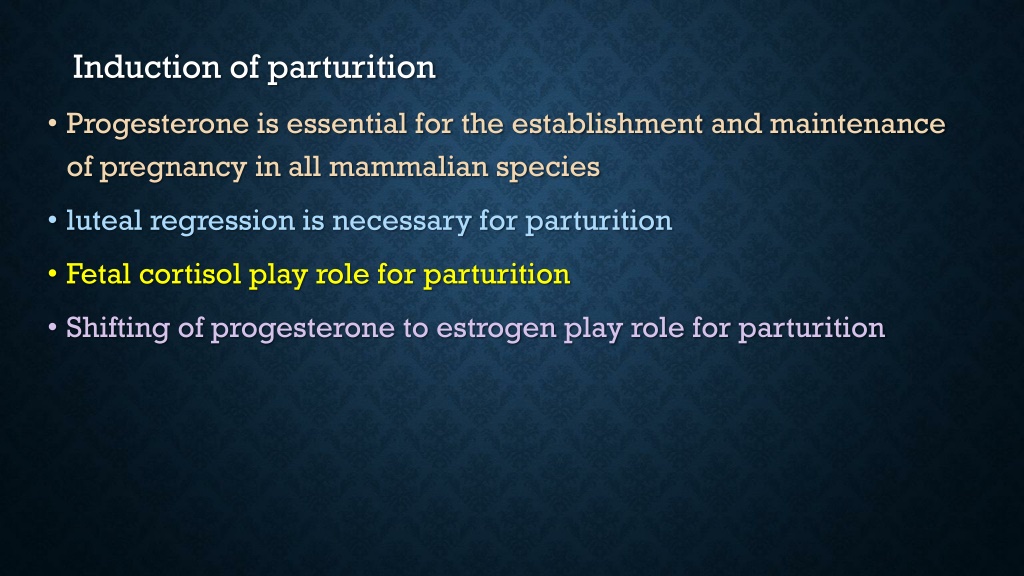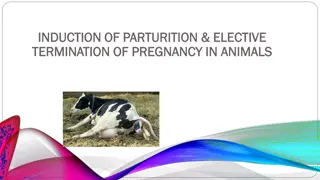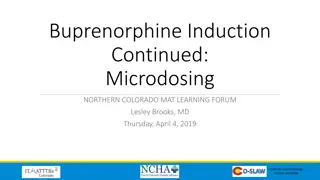Understanding Induction of Parturition in Mammals
Induction of parturition in mammals involves the essential roles of progesterone, luteal regression, fetal cortisol, and the shift from progesterone to estrogen. This process is crucial for saving the lives of both the dam and fetus. Corticosteroids like dexamethasone and flumethasone are commonly used to induce parturition with high efficacy. The success of induction can be determined within 72 hours, with retreatment being an option. Long-acting corticosteroids are used in specific scenarios, and their effects on cow health and milk production are observed.
Download Presentation

Please find below an Image/Link to download the presentation.
The content on the website is provided AS IS for your information and personal use only. It may not be sold, licensed, or shared on other websites without obtaining consent from the author. Download presentation by click this link. If you encounter any issues during the download, it is possible that the publisher has removed the file from their server.
E N D
Presentation Transcript
Induction of parturition Progesterone is essential for the establishment and maintenance of pregnancy in all mammalian species luteal regression is necessary for parturition Fetal cortisol play role for parturition Shifting of progesterone to estrogen play role for parturition
Purpose of induction of parturition Save the life of dam Save the life of fetus
Short-acting corticosteroids The most commonly used corticosteroids for inducing parturition are dexamethasone (20 30 mg) and flumethasone (8 10 mg) given as a single intramuscular injection. Parturition is induced with 80 90% efficacy when the injection is given within 2 weeks of normal term The interval from injection to parturition is 24 72 hours, with an average of 48 hours
In cows that have not calved by 72 hours after treatment the induction is considered to have failed Retreatment in such cases is often successful in inducing parturition Relaxation of the pelvic ligaments, cervical dilation and filling of the udder occur rapidly, and labor and parturition are normal Calves born less than 2 weeks prematurely are vigorous and calf mortality is not increased The actual secretion of milk at the onset may not be plentiful in induced cows; however, colostral immunoglobulin levels and total milk production for the lactation period are very close to normal.
Long-acting corticosteroids Long-acting corticosteroids are not used when calf viability is of primary importance Wide acceptance where seasonal milk production is of primary importance and calving (lactation) is synchronized with the grazing season Dexamethasone trimethylacetate (25 mg) or triamcinolone acetonide (4 8 mg) may be used and appear to provide similar outcomes
An intramuscular injection is given once 24 weeks prior to the due date for calving and parturition occurs over a wide range of 4 26 days Despite prolonged elevated systemic corticosteroid levels, cow health is generally good; however, preexisting diseases, particularly subclinical infections, may be exacerbated by the treatment and there is a potential increase in cow mortality The udders of treated cows are consistently engorged with milk about 1 week after injection, although it may be another week before they actually calve
The incidence of retained placentas with the use of longacting corticosteroids is quite low (9 22%) compared with short-acting corticosteroids However, there is a high incidence of calf mortality (7 45%), which appears to be due to premature placental separation, an increased frequency of uterine inertia, and calf prematurity The variability in response to treatment with a long-acting corticosteroid can be reduced by treating with a short-acting corticosteroid or prostaglandin about a week after the long-acting corticosteroid treatment.19 Most cows will calve 2 3 days after the second injection
Prostaglandins Induction of parturition with prostaglandins intramuscularly gives very similar results to induction with short-acting corticosteroids, with a range of 24 72 (mean 44.9) hours from treatment to calving As with short-acting corticosteroid- induced parturitions, there is a high incidence of retained placentas and a 10 20% rate of induction failure when treatments are given within 2 weeks before normal term The later the stage of gestation at which prostaglandins are administered, the greater the efficacy with which a single injection induces calving.
Long-acting corticosteroids in combination with dexamethasone and cloprostenol for daylight calving and a low incidence of retained Corticosteroids and prostaglandins in combination
Induction of parturition according to the animals types Sheep Goat Mare Cows Camels Buffalos























